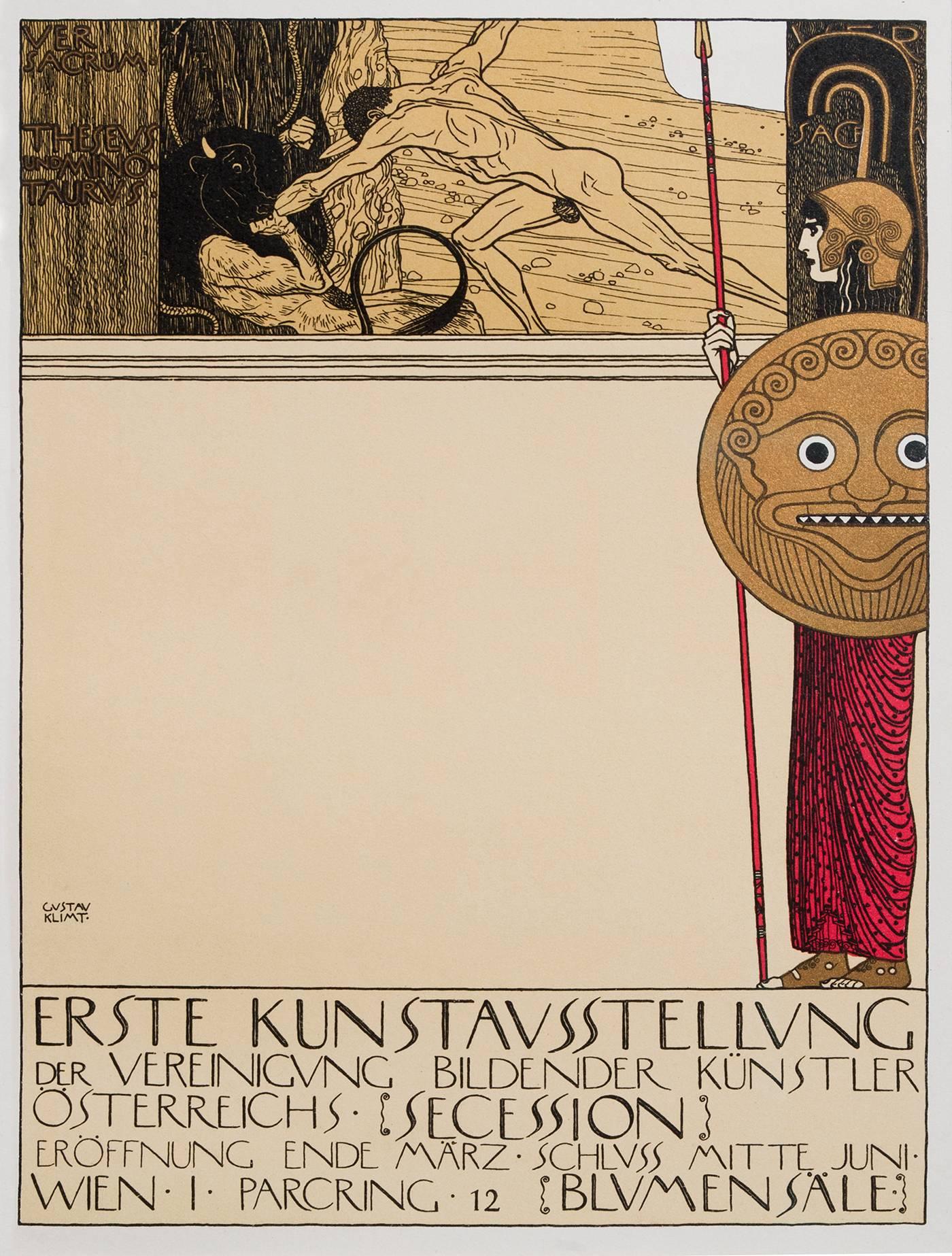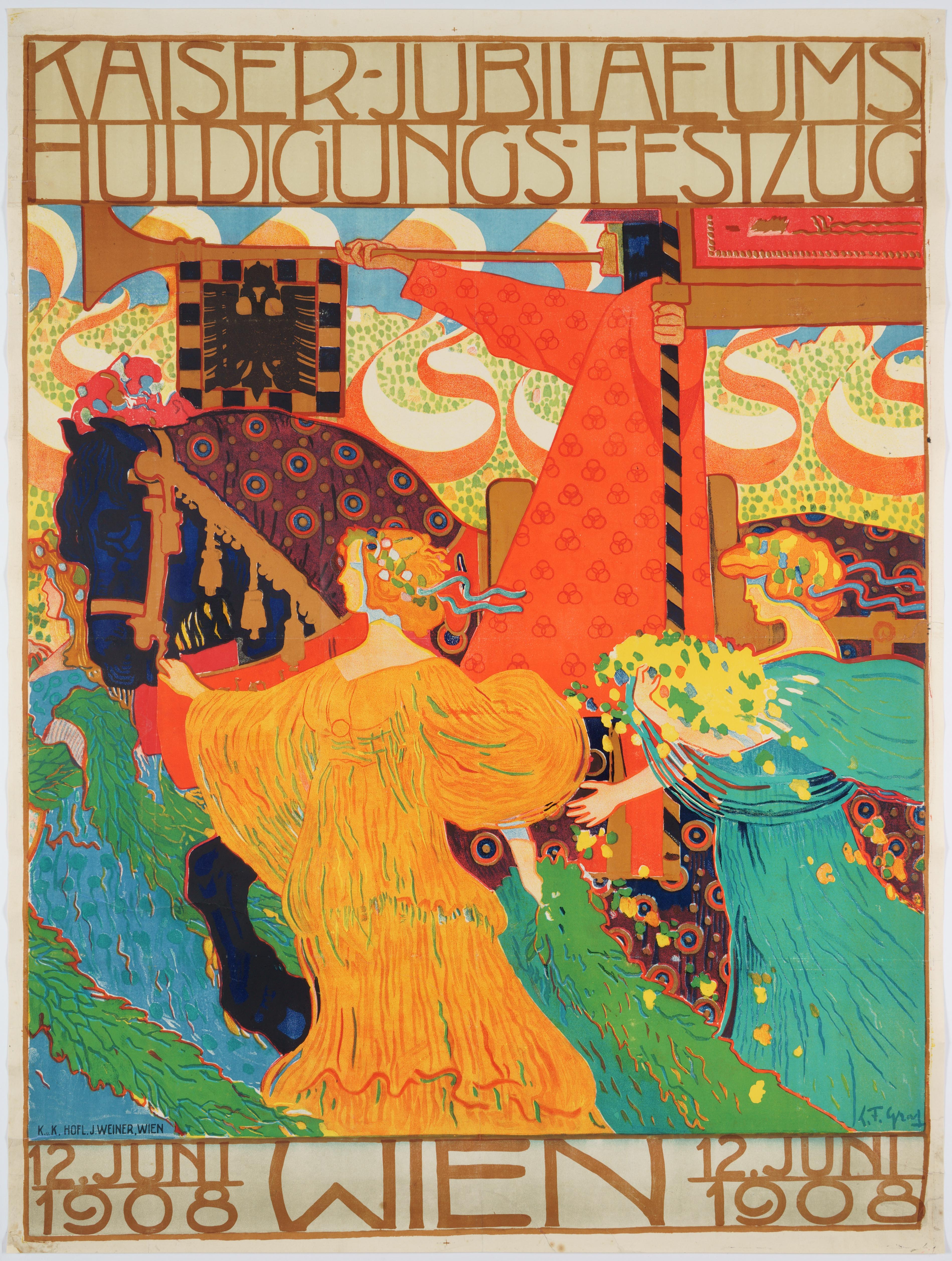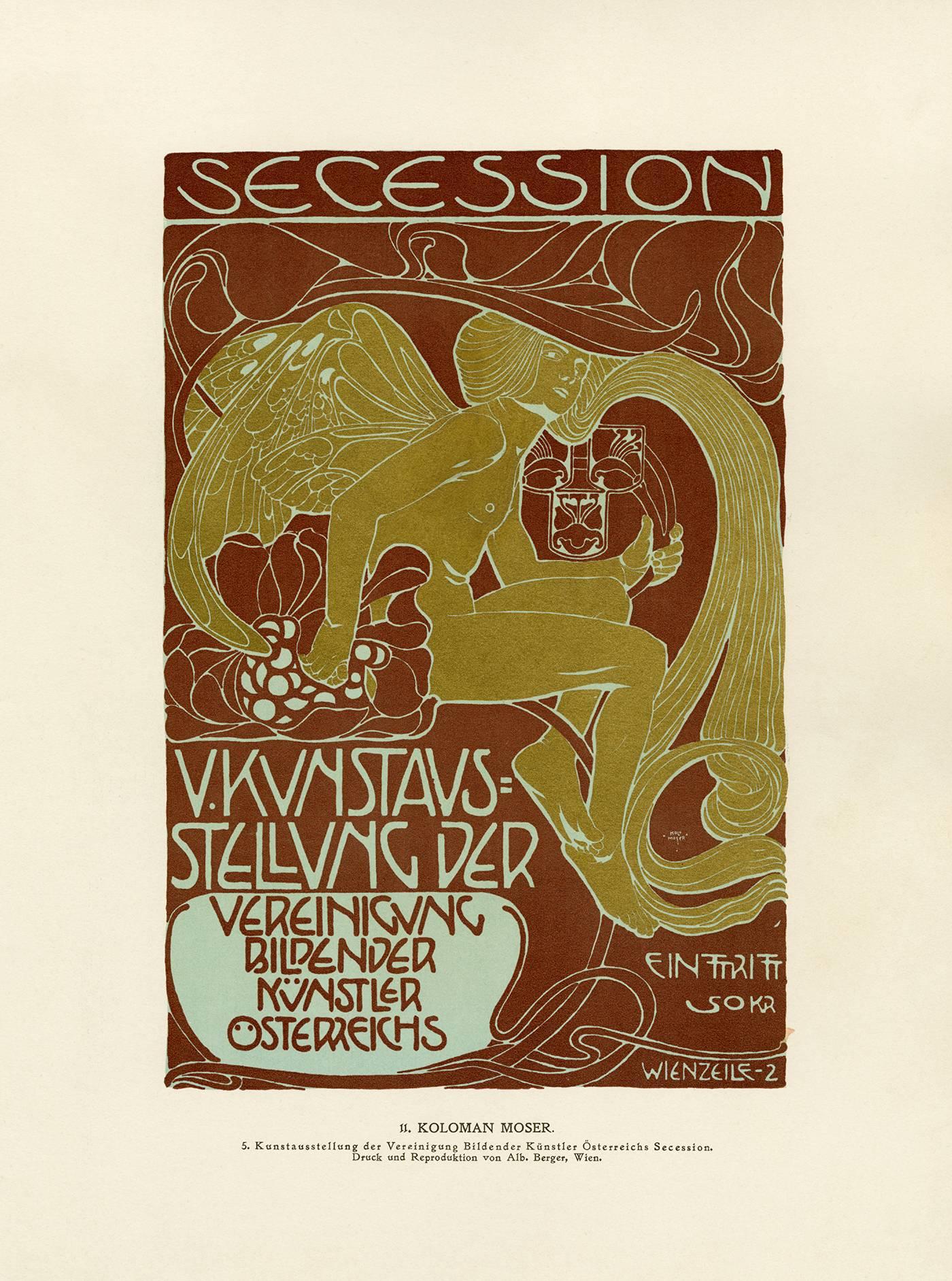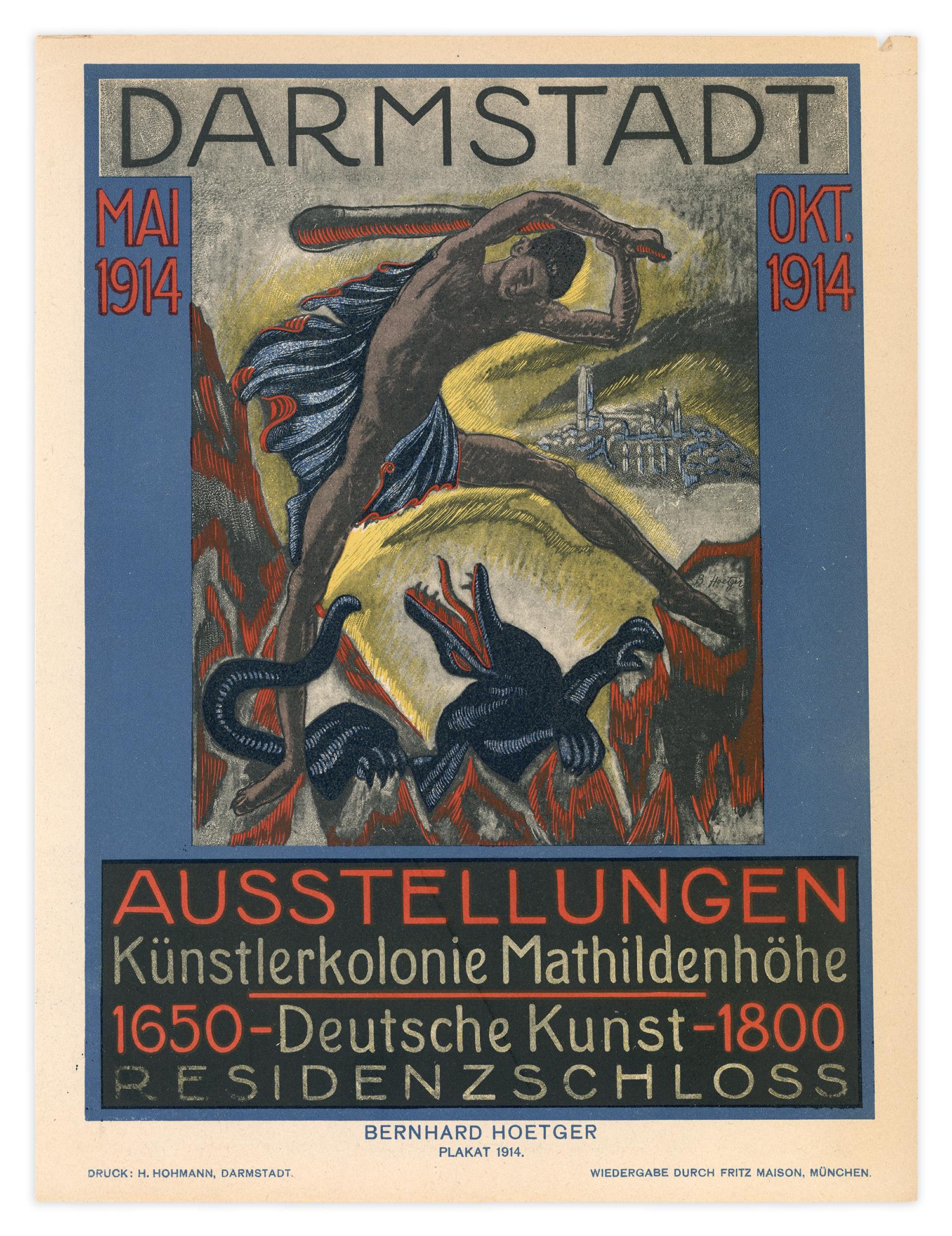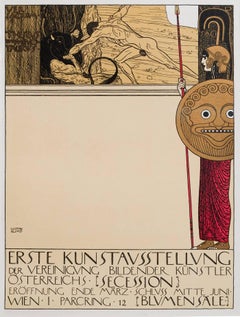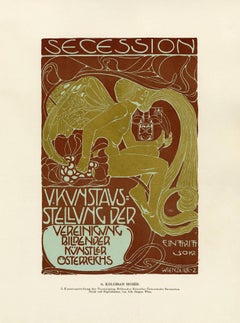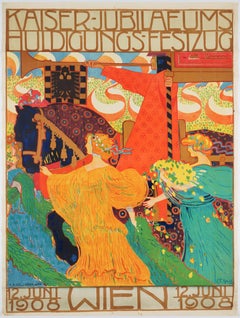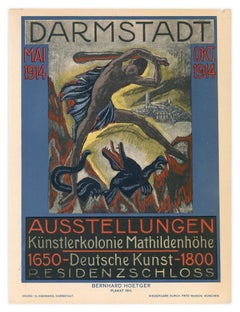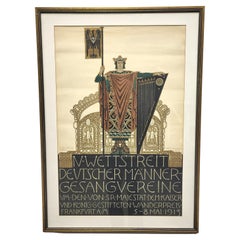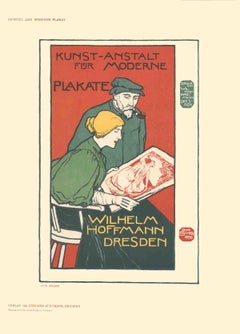Items Similar to Ottokar Mascha Folio, plate 9: "Darmstadt Poster"by Joseph Maria Olbricht
Want more images or videos?
Request additional images or videos from the seller
1 of 6
Joseph Maria OlbrichOttokar Mascha Folio, plate 9: "Darmstadt Poster"by Joseph Maria Olbricht1915
1915
$5,200
£3,945.04
€4,523.21
CA$7,407.71
A$8,039.19
CHF 4,229.88
MX$97,676.35
NOK 52,957.25
SEK 49,864.07
DKK 33,772.80
About the Item
After JOSEPH MARIA OLBRICHT (1867-1908) DARMSTADT POSTER, 1901, (In Mascha, no. 9) One of the founding members of the Vienna Secession and a highly esteemed architect, Olbricht was charged with designing the group’s permanent exhibition hall which opened in 1898. With its modular and moveable spaces, the Secession building’s interior is as remarkable as the exterior for its modernity. The following year, Grand Duke Ernst Ludwig von Hessen founded the Darmstadt Artist’s Colony in Mathildenhohe, Germany with the intention of joining architecture, art and artisanal production. One of seven who were invited to live, work and teach in the the new community, Olbricht designed most of the houses there. In this poster for the first of what would be four exhibitions at Darmstadt between 1901-1914, he fuses the disciplines of architecture and graphic design by creating a geometry of form through the complementary pattern of basic shapes and the letter, D.
OTTOKAR MASCHA (1852-1929), OSTERREICHISCHE PLAKATKUNST, 1915, J. Lowy Printer, in an edition of 230.
Austria’s foremost collector of poster prints, Ottokar Mascha amassed one of the largest international graphic art collections of the time. He was an active member in poster-collecting societies, and he gave generously to educational and other public institutions. In many cases, examples found in his collections were the sole survivors of an ephemeral medium whose delicate papers could not hold up over time to the damaging effects of animal glue, weathering, and other wear and tear from excessive handling. Mascha recognized that posters were not only cultural documents, but works of art. He devised ways to obtain pristine examples for his collection often through the police with whom posters needed to be submitted for approval prior to being hung in public. As Mascha explains in the forward and introduction of Plakatkunst, he saw a need in Austria for developing and promoting the poster as an artistic medium. His aims in publishing Plakatkunst were lofty; Mascha hoped to educate new and aspiring Austrian artists by exposing them to the possibilities the poster medium offered, and he hoped to develop a broader collector base through connoisseurship. His carefully selected examples of posters from his collection are archives of a nearly lost time. Preserved within this rare printed work are contextual links to Austria’s interconnected modern arts culture of which the Vienna Secession played a central role. Like the members of Vienna’s Secession, Mascha believed that modernity required a new definition of Art and that old hierarchical notions were out of touch. Creating a leveling force in the arts, where graphic and applied arts are valued equally as painting, sculpture and architecture, was an over-arching goal many were grappling to achieve at this time. He also shared the belief that, whether native or adoptive, there was, indeed, an Austrian sensibility whose zeitgeist he wanted to capture and preserve. For him, it was a question of accessibility. Today, bombarded as we are with digital and graphic images and their instant access we have literally at our fingertips, it is easy to forget that 100 years ago this was simply not the case. Plakatkunst, was, and is, an invaluable resource; it is a bold statement which continues to resound that the artistic merit of successful posters will stand the test of time.
- Creator:Joseph Maria Olbrich (1867 - 1908, Austrian)
- Creation Year:1915
- Dimensions:Height: 14.9 in (37.85 cm)Width: 14.6 in (37.09 cm)
- Medium:
- Movement & Style:
- Period:
- Condition:
- Gallery Location:Chicago, IL
- Reference Number:1stDibs: LU467314042662
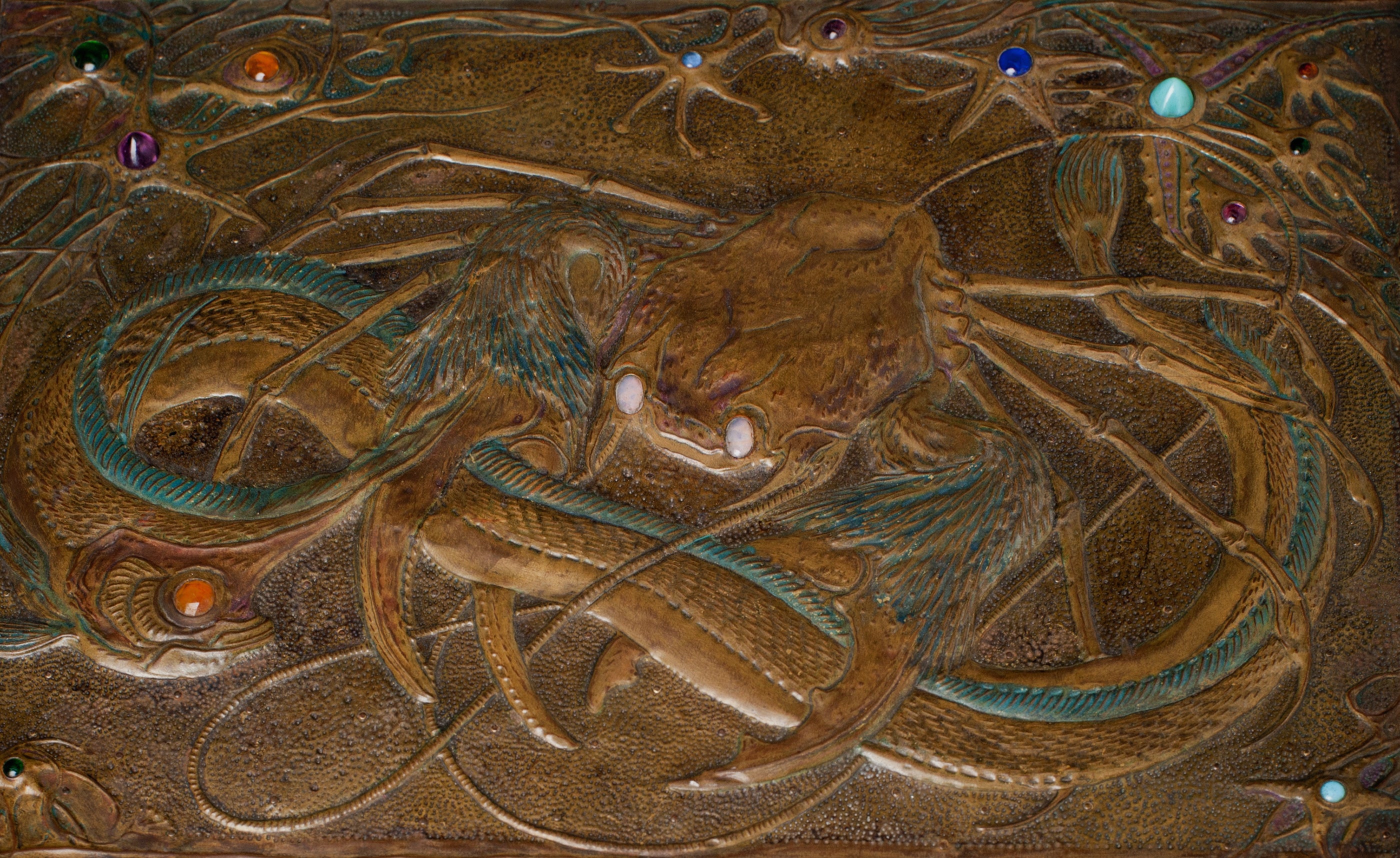
About the Seller
5.0
Gold Seller
Premium sellers maintaining a 4.3+ rating and 24-hour response times
Established in 2013
1stDibs seller since 2016
99 sales on 1stDibs
Typical response time: 6 hours
- ShippingRetrieving quote...Shipping from: Chicago, IL
- Return Policy
Authenticity Guarantee
In the unlikely event there’s an issue with an item’s authenticity, contact us within 1 year for a full refund. DetailsMoney-Back Guarantee
If your item is not as described, is damaged in transit, or does not arrive, contact us within 7 days for a full refund. Details24-Hour Cancellation
You have a 24-hour grace period in which to reconsider your purchase, with no questions asked.Vetted Professional Sellers
Our world-class sellers must adhere to strict standards for service and quality, maintaining the integrity of our listings.Price-Match Guarantee
If you find that a seller listed the same item for a lower price elsewhere, we’ll match it.Trusted Global Delivery
Our best-in-class carrier network provides specialized shipping options worldwide, including custom delivery.More From This Seller
View AllOttokar Mascha Folio, plate 8: "Poster for the 1st Vienna Secession Exhibition"
By Gustav Klimt
Located in Chicago, IL
After GUSTAV KLIMT (1862-1918) THESEUS UND MINOTAURUS, 1898, final design submission for poster advertising the first exhibition of the Vienna Secession, (In Mascha, no. 8) As a cele...
Category
1910s Vienna Secession Figurative Prints
Materials
Lithograph
Poster for the 15th Exhibition of the Vienna Secession by Adolf Michael Bohm
By Adolf Boehm
Located in Chicago, IL
Note: Due to the size, weight, and value of this piece, we require shipping through 1stDibs, for its cost effectiveness, full insurance coverage, and reliable handling. While standar...
Category
Early 1900s Vienna Secession More Prints
Materials
Lithograph
Ottokar Mascha Folio: plate 11 "5th Secession Exhibition Poster" by Kolo Moser
By Koloman Moser
Located in Chicago, IL
after KOLOMAN MOSER (1868-1918) 5TH SECESSION EXHIBITION POSTER, 1899, (In Mascha, no. 11) A pivotal figure in early-20th century Austrian ...
Category
1910s Vienna Secession Figurative Prints
Materials
Lithograph
Poster for the 12th Exhibition of the Vienna Secession by Alfred Roller
Located in Chicago, IL
Note: Due to the size, weight, and value of this piece, we require shipping through 1stDibs, for its cost effectiveness, full insurance coverage, and reliable handling. While standar...
Category
Early 1900s Vienna Secession More Prints
Materials
Lithograph
Poster for the 17th Exhibition of the Vienna Secession by Max Kurzweil
By Adolf Boehm
Located in Chicago, IL
Note: Due to the size, weight, and value of this piece, we require shipping through 1stDibs, for its cost effectiveness, full insurance coverage, and reliable handling. While standar...
Category
Early 1900s Vienna Secession More Prints
Materials
Lithograph
"Laderlappen" Original Lithograph Poster by Walter Schnackenberg
By Walter Schnackenberg
Located in Chicago, IL
Printed by Oscar Consee, Munich, 1922
Not much is known about this Stockholm-based cabaret act. Translating literally as Bat Man, we see a young dancer tease an oversized bat wearing a monocle -- a truly bizarre but beautiful design. (text by Jack Rennert)
Walter Schnackenberg’s style changed several times during his long and successful career. Having studied in Munich, the artist traveled often to Paris where he fell under the spell of the Henri de Toulouse-Lautrec’s colorful and sensuous posters depicting theatrical and decadent subjects. Schnackenberg became a regular contributor of similar compositions to the German magazines Jugend and Simplicissimus before devoting himself to the design of stage scenery...
Category
1920s Art Nouveau Figurative Prints
Materials
Lithograph
You May Also Like
Original Vintage Secession Poster celebrating the emperor's jubilee
Located in Zurich, CH
Original Vintage Poster by the Austrian artist Ferdinand Ludwig Graf, a member of the Hagenbund. This Viennese artist association moved as soon a...
Category
Early 1900s Vienna Secession Figurative Prints
Materials
Paper
Fourth Darmstadt exhibition, Expressionist dragon poster, Bernhard Hoetger, 1914
By Bernhard Hoetger
Located in Chicago, IL
Bernhard Hoetger’s 1914 Expressionist poster for the Darmstadt Artists' Colony’s (Darmstädter Künstlerkolonie) fourth and final exhibition depicts the legend of Saint George slaying ...
Category
1910s Expressionist Prints and Multiples
Materials
Offset
Original Vintage Poster Otto Linnemann Wettstreit Männer Gesangvereine 1913
Located in Aachen, NW
Very rare original vintage 1st printing poster by Otto Linnemann in 1913.
Wettstreit Deutscher Männer Gesangvereine.
This Jugendstil "Wettstreit Deutscher Männer Gesangvereine" post...
Category
Vintage 1910s German Posters
Materials
Paper
1897 After Otto Fischer 'Kunst-Anstalt fur Moderne Plakate'
Located in Brooklyn, NY
Paper Size: 11.5 x 8.25 inches ( 29.21 x 20.955 cm )
Image Size: 8.5 x 5.5 inches ( 21.59 x 13.97 cm )
Framed: No
Condition: A: Mint
Additional Details: First printing Lithogr...
Category
19th Century Art Nouveau Prints and Multiples
Materials
Lithograph
$100 Sale Price
20% Off
1901 Original poster by Alfred Roller Wiener Kunststickereien Vienna Secession
Located in PARIS, FR
Beautiful, original poster, emblematic of advertising art created by Austrian artist Alfred Roller. Roller was a versatile artist at the turn of the 20th...
Category
Early 1900s Art Nouveau Prints and Multiples
Materials
Lithograph, Paper
1906 original poster Niederlandisch Indische Kunstausstellung Krefeld
By Jan Thorn Prikker
Located in PARIS, FR
The 1906 original exhibition poster by Thorn Prikker Johann promotes the "Niederländisch-Indische Kunstausstellung" (Dutch East Indies Art Exhibition) held in Krefeld at the Kaiser W...
Category
Early 1900s Art Nouveau Prints and Multiples
Materials
Paper, Lithograph
